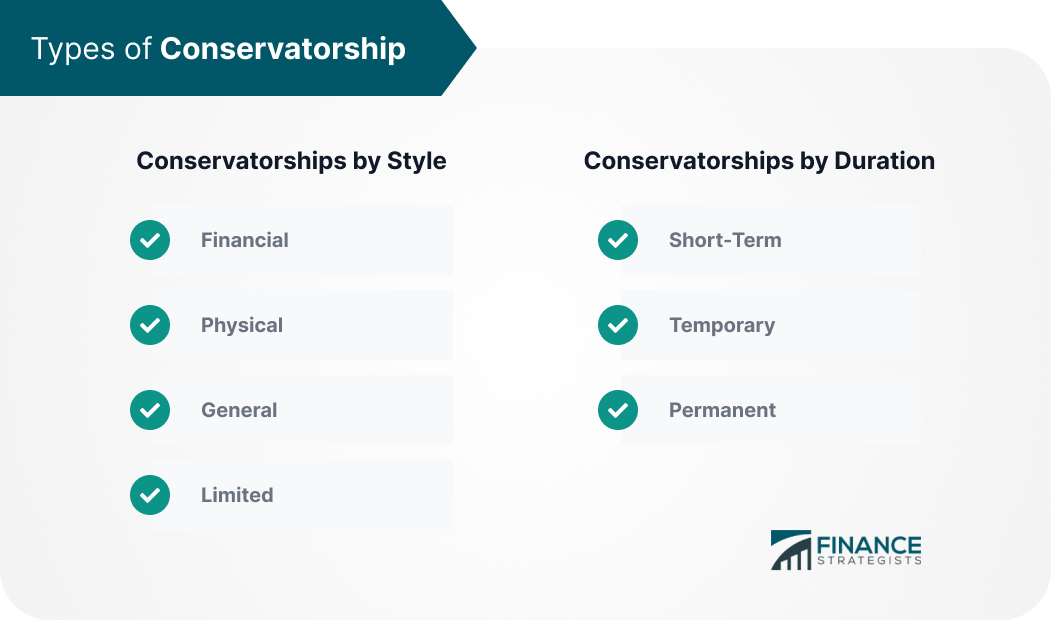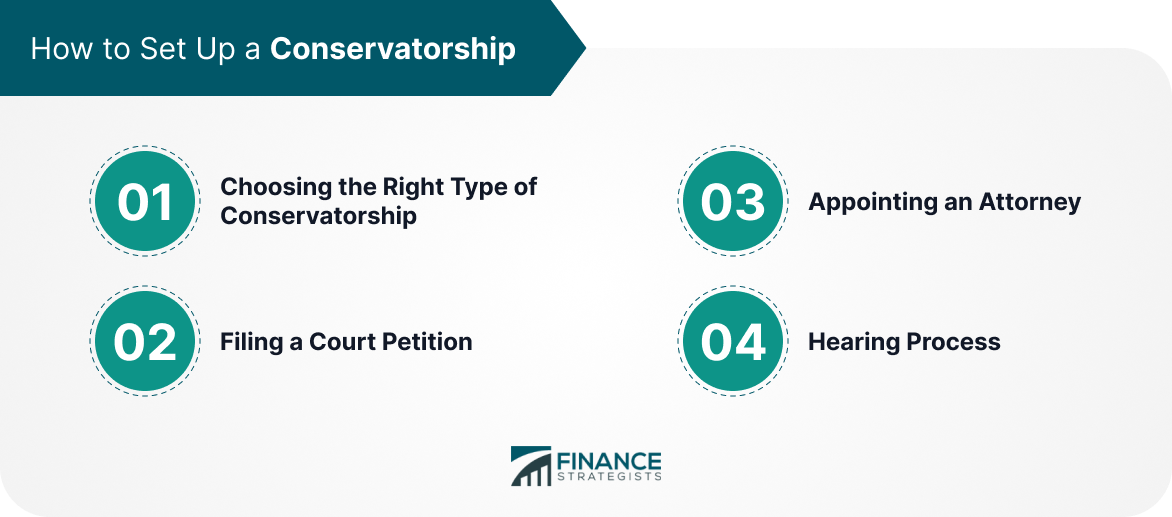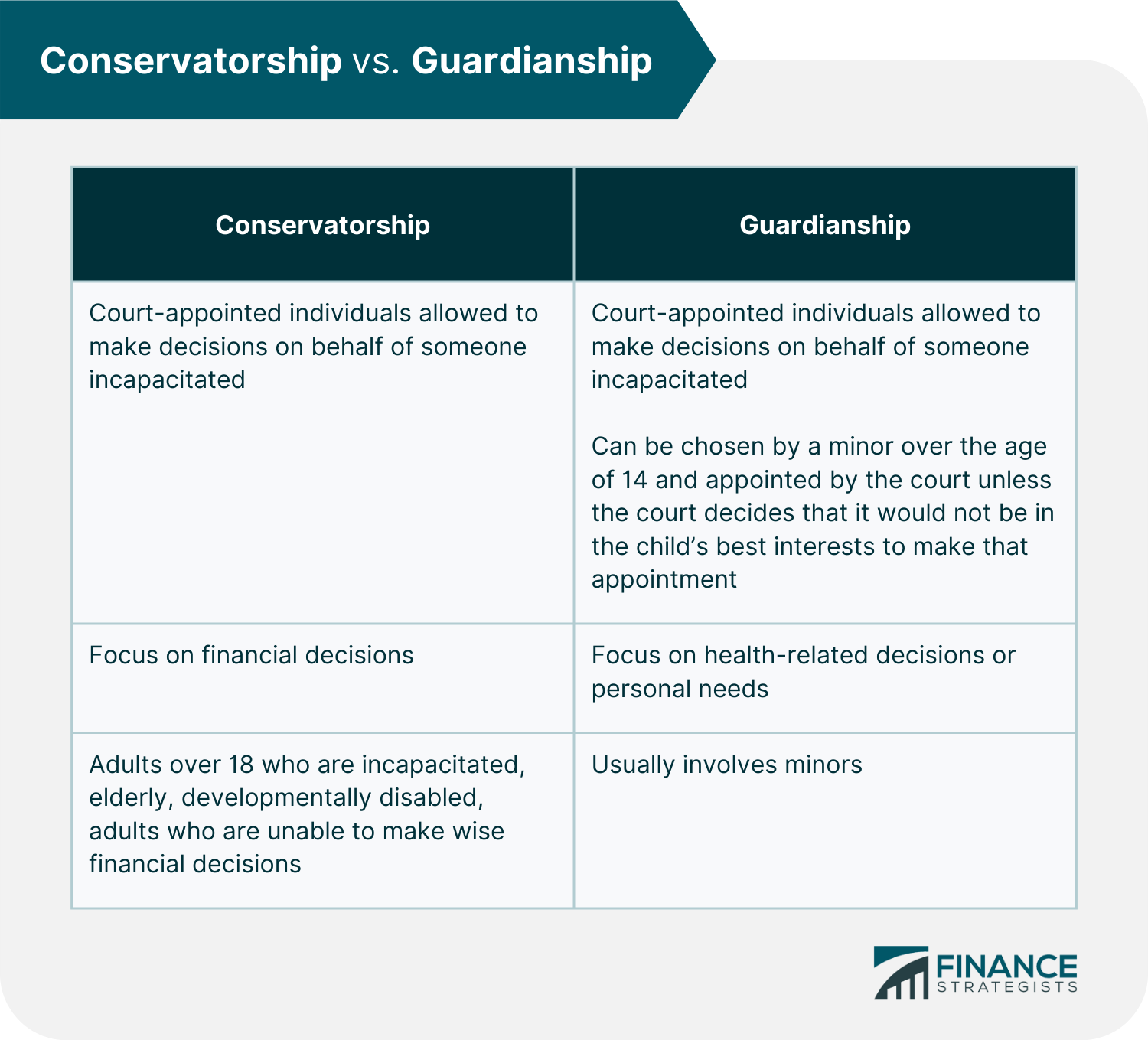A conservatorship is a legal settlement in which an individual, called a conservator, is appointed by a court to manage the financial and/or medical affairs of another person, called a conservatee. The conservator has a duty to act in the best interests of the conservatee. Conservatorships are used when an individual, the conservatee, is unable to manage their own affairs due to incapacity. The court will designate a conservator to make financial and medical decisions on behalf of the conservatee. The conservatorship process begins when the proposed conservatee, a potential conservator or anyone concerned files a petition with the court. The court will then appoint a temporary conservator, who will manage the conservatee's finances until a trial is conducted to assess if a permanent conservatorship order is necessary. The conservator is typically a family member or close friend, but can also be a professional fiduciary. The conservator has authority over the conservatee's financial security and must use the conservatee's assets in a manner that is in the conservatee's best interests. The conservator must also keep accurate records of all transactions and report periodically to the court. Scenarios in which conservatorship would be appropriate is covered in the following section. Minors with parents who are unable to care for them due to illness, death, or other circumstances will only require conservators if they are a beneficiary of some financial asset or life insurance policy. Otherwise, minors would only need a guardian to oversee their welfare. Conservatorship for an adult is sought when the individual in question is unable to make sound decisions about their own welfare or finances. This may be due to cognitive impairment, such as dementia, or psychological incapacity. The court oversees the process and if there is enough evidence to support the petition, the conservator has the jurisdiction to make decisions on behalf of the conservatee regarding medical care, living arrangements, and financial matters. The court appoints a conservator to individuals who suffer from physical, mental and developmental disabilities, only after verifying that the individual is unable to adequately provide for their own basic needs, unable to make sensible decisions about their own welfare and that appointing a conservator is in the individual's best interests. The procedure generally begins as soon as the potential ward is 16 or 17 years old and the aim is for legal arrangements to take effect the day the prospective ward reaches 18. Corporate conservatorship is a legal arrangement in which a company's board of directors is removed from power and replaced with a conservator. This can happen when a company is facing financial difficulties or when it has been accused of misconduct. The conservator is typically appointed by a court and has the authority to make decisions about the company's affairs. The goal of corporate conservatorship is to protect the interests of shareholders, creditors, and other stakeholders. Conservatorships differ in terms of style and duration of the agreement. A financial type of conservatorship is limited to the management of the conservatee's finances. It does not give the conservator any authority over the individual's medical decisions or living arrangements. Physical In a physical conservatorship, the conservator has control over the conservatee's health and well-being. The conservator has control over where the conservatee lives, how they are cared for, and whether or not they need to move into a nursing home. A common conservatorship style where the conservator has complete control over the conservatee's finances, physical independence, health, and all other major decisions. The conservator has control over certain aspects of the conservatee's life and specific needs. This is frequently granted in the case of a mentally disabled adult to allow continuous care while also allowing the maximum amount of autonomy possible. This type of conservatorship is put in place to address specific and immediate needs of the conservatee. It typically lasts no more than 90 days. This usually happens when someone becomes unexpectedly incapacitated. Conservatorships allowed without a formal hearing are also classified as short-term. This is a conservatorship that lasts for a set period of time or under certain conditions. For example, if someone falls into a medical coma, a judge may grant a temporary conservatorship until the person awakens. This is a kind of conservatorship that will last for the rest of the individual's life, unless circumstances change. The individual may file to have it revoked, but in order to succeed, they must present their case and obtain a court order. Let us look at some examples of famous and high-profile conservatorships that have been established. A popular conservatorship involved Britney Spears, a successful child star who began making significant money at a young age. The aftermath of her divorce and losing custody of her children, coupled with several public breakdowns, resulted in her father, Jamie Spears, being granted a conservatorship over her in 2008 by a California judge. Due to health reasons, her father stepped down from being conservator in 2019 but he was replaced by a court-appointed care professional. Britney remained under conservatorship until November 2021. In 2008, Fannie Mae and Freddie Mac, two government-sponsored enterprises (GSEs), were taken into conservatorship by the U.S. government after they were on the brink of collapse due to the mortgage crisis. The Federal Housing Finance Agency (FHFA) was their appointed conservator. The conservatorship allowed the U.S. Treasury to provide capital to the two mortgage giants and also to buy their stock as an attempt to keep them afloat and ensure that they continued to provide liquidity in the mortgage market. Fourteen years later, Fannie Mae and Freddie Mac are still in conservatorship today. When a person can no longer make decisions about their own care or finances, a conservatorship may be the best option to ensure that they receive the help they need. A conservatorship provides the court with supervision and control over the decisions made about the conservatee’s (the person who cannot make decisions) care and finances. Conservatorships protect individuals from financial exploitation. This means that a conservator regularly provides the court with financial information and can be held accountable for their actions and must follow court orders. A conservator owes the conservatee a fiduciary duty, which is a legal duty to act in the conservatee’s best interests. This duty is higher than the duty owed to friends or family members. This requires the conservator to put the conservatee’s interests above their own. They ensure that conservatees receive the level of care that they deserve. If the conservator breaches this duty, they can be held liable in court. When a conservatorship is necessary, it can dramatically improve the quality of life for the conservatee. This is because the conservator has the legal authority to make decisions that will ensure the conservatee’s safety and well-being. For example, the conservator can make sure that the conservatee is living in a safe environment, receiving the medical care they need, and has access to financial resources. There are some potential drawbacks to conservatorships that should be considered before this legal arrangement is put in place. The process of conservatorship can be costly and time-consuming. This is because the court must appoint a conservator, which often requires hiring an attorney. In addition, the conservator must regularly report to the court, which drains time and financial resources. Another potential drawback of a conservatorship is that it can result in the public disclosure of the conservatee’s assets. This is because the court records are typically available to the public, which means that anyone can see how much money the conservatee has and what they are doing with it. Finally, it cannot be denied that a conservatorship can limit the decisions that the conservatee can make about their own life. The conservatee will no longer have the legal authority to make decisions about their own care or finances, a difficult adjustment for someone who is used to making their own decisions. Conservatorships require conservators who are usually family members or friends, but they can also be professional fiduciaries appointed by the court in the absence of anyone willing to do the job. The following are steps to be taken to set up a conservatorship. There are different types of conservatorship and it is important to determine if a conservatorship is appropriate for the situation. Know the purpose and limitations of each type before making a decision. The next step is to file a court petition. This can be done by the conservatee themselves, the potential conservator, or anyone with knowledge of the situation. The court reviews and accepts the petition and will identify a hearing date. After the hearing date is set, the court will appoint an attorney for the conservatee. This is to ensure that their rights are protected during the legal process. On the day of the hearing, the judge will hear evidence and testimony from both sides before making a decision. If the judge decides that a conservatorship is necessary, they will appoint a conservator and order the transfer of legal authority. Several alternatives to conservatorship might be looked at before it is implemented. A legal form known as a power of attorney gives another person the authority to make decisions on your behalf. An advantage of the power of attorney is that the process still allows you to maintain control over your own life and there is no need to go to court for the appointment. It can also be easily revoked at any time. A representative payee is the appointed person or organization that the Social Security Administration designates to manage and receive benefits on behalf of someone else. This arrangement is typically used for people who are unable to manage their own finances, but it does not give the representative payee the authority to make medical decisions. In special needs trust, a person with mental or physical disability, or chronically ill, is insured by being a beneficiary of a trust fund that will improve their quality of life without losing their eligibility for government benefits. Beneficiaries maintain control of their assets through a trustee. Another alternative to conservatorship is joint property or joint bank account ownership. This arrangement allows two or more people to own property or accounts together, and each person has the power to make decisions about the property or account. Conservatorship is typically used when an individual is unable to make financial or medical decisions for themselves. A conservator is given the legal authority to make these decisions on behalf of the individual in question. Guardianship, on the other hand, is typically used when an individual is unable to make decisions about their own personal care. This could include things like where they will live, what kind of medical treatment they will receive, and what type of assistance they will receive with activities of daily living. A conservator can only make financial and medical decisions on behalf of the individual, while a guardian can make decisions about all aspects of their personal care. A conservatorship can be a helpful tool for individuals who are unable to make financial or medical decisions for themselves. The process of conservatorship appoints a legal conservator to make these decisions on behalf of the conservatee, giving them peace of mind that their affairs are being managed by someone they trust. Conservatorship can help protect the conservatee's assets and ensure that their medical and financial needs are being taken care of. However, it is worth noting that a conservatorship can also be a difficult adjustment for the conservatee, as it limits their ability to make decisions about their own life. There are also several alternatives to conservatorship that might be more appropriate in certain situations. The appropriate line of action will ultimately depend on the individual's specific needs and circumstances.What Is a Conservatorship?
How Does Conservatorship Work?
For Minors
For Incapacitated Adults
For Developmentally-Challenged Adults
For Corporations and Organizations
Types of Conservatorship

Conservatorships by Style
Financial
General
Limited
Conservatorships by Duration
Short-Term
Temporary
Permanent
Conservatorship Example
Britney Spears Conservatorship
Fannie Mae and Freddie Mac Conservatorship
Benefits of a Conservatorship
Court Supervision and Control
Protection Against Fiduciary Duty Breach
Legal Authority of Conservator
Drawbacks of Conservatorship
Costly and Time-Consuming
Publicity of Conservatee’s Assets
Limited Decisions of the Conservatee
How to Set Up a Conservatorship

Choosing the Right Type of Conservatorship
Filing a Court Petition
Appointing an Attorney
Hearing Process
Alternatives to Conservatorship
Power of Attorney
Representative Payee
Special Needs Trust
Joint Property or Joint Bank Account Ownership
Conservatorship vs Guardianship

Conclusion
Conservatorship FAQs
Conservatorship is a legal procedure in which an individual (known as the conservatee) is placed under the care of another person (known as the conservator). The conservator is typically responsible for making financial and medical decisions on behalf of the conservatee.
Britney Spears was under conservatorship because she was deemed unable to make financial or medical decisions for herself. She exhibited erratic behavior after her divorce and losing custody of her children, leading to several public breakdowns. This granted her father conservatorship over her.
A conservator can be anyone over the age of 18 who is willing and able to take on the responsibility of making financial and medical decisions on behalf of the conservatee. The conservator must also be someone that the conservatee trusts, as they will be given a great deal of authority over the individual's life.
Conservatorship is employed when individuals are unfit to make financial or medical decisions for themselves. Guardianship, in contrast, is specified when an individual is unable to make decisions about their personal care. A conservator can only make financial and medical decisions on behalf of the individual, while a guardian can make decisions about all facets of their personal care.
A conservatorship might be necessary if an individual is unable to make financial or medical decisions for themselves. There are multiple grounds for this, including old age, mental illness, physical and developmental disability, and chronic illness. Conservatorship can also be applied to minors who are unable to make financial and medical decisions for themselves.
True Tamplin is a published author, public speaker, CEO of UpDigital, and founder of Finance Strategists.
True is a Certified Educator in Personal Finance (CEPF®), author of The Handy Financial Ratios Guide, a member of the Society for Advancing Business Editing and Writing, contributes to his financial education site, Finance Strategists, and has spoken to various financial communities such as the CFA Institute, as well as university students like his Alma mater, Biola University, where he received a bachelor of science in business and data analytics.
To learn more about True, visit his personal website or view his author profiles on Amazon, Nasdaq and Forbes.











